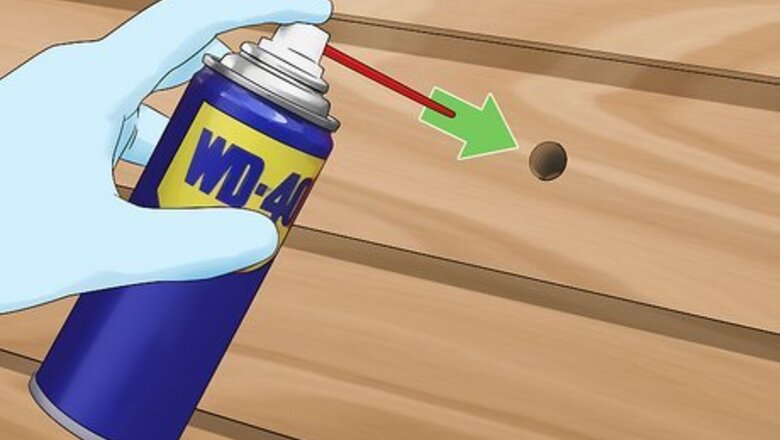
views
Spraying the Bees
Locate the small circular holes in wood. Carpenter bees drill deep holes. They are around ⁄2 inch (1.3 cm) in diameter and they usually go for pine, fir, oak, and redwood. In the early spring when the bees start nesting, look around your home for signs of carpenter bee activity. Check around: Doors Windowsills Roof eaves Railings Decks Fences Sheds
Put on gloves and eye protection. It's a good idea to wear long-sleeved clothes anytime you're trying to get rid of bees. Pop on a pair of gloves and goggles, too. These protect your skin from irritation since WD is harsh. If you do get WD40 on your skin, wash it thoroughly with soapy water.
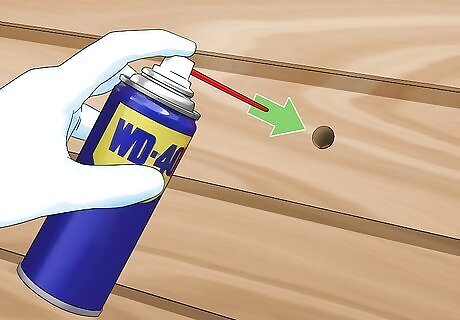
Stick the long, thin WD40 straw into the hole. Push the red straw-like attachment onto the can's nozzle. Then, insert the red straw into a carpenter bee hole. Since there's no telling how deep the tunnel goes, try to push the straw in at least 1 inch (2.5 cm). Do this towards the end of the day when the bees are more likely to be back in their nests.
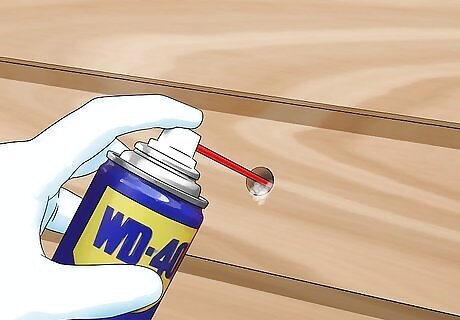
Spray the WD40 for several seconds. You may see white, foamy liquid oozing out of the hole—that's totally fine. It just means that you've coated the inside of the hole and the pressure is forcing the WD40 out. Excess WD40 will drip onto the ground below the hole so if you don't want it getting messy, put down a tarp before you spray.
Seal up the hole after 24 hours. Most carpenter bees will crawl out of the hole and fall onto the ground where they'll die. Then, you can push a wooden dowel into the hole and fill in the space around it with wood putty before you let it dry completely. It's really important to do this after you spray since the female bees can simply bore out of the hole if you don't coat them with WD40 first. You can buy wooden dowels at most hardware stores and you can cut the length down to size so they fit in your board.
Hire a professional if you can't get rid of the bees. You can also ask a professional company to relocate the bees if you don't want to kill them. It usually costs between $75 and $500 to get rid of carpenter bees. The price depends on how many bees you need to have removed and how infested your home is. Keep in mind that your home may need some repairs after the bees are gone. For instance, you may want to hire a contractor to replace wooden boards on a deck or shed.
Preventing Future Infestations
Fill cracks or holes in wood with putty. Carpenter bees frequently find existing holes or cracks to nest in rather than drilling new holes. In early spring before nesting season, seal up cracks, nail holes, and splintered wood with wood putty. Although you can use caulking to fill in holes, it can shrink over time so you may need to re-seal the holes.
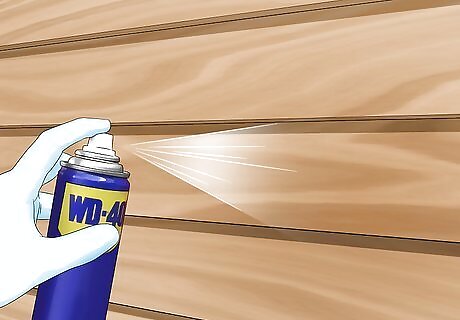
Spray untreated wood with WD40 to repel the bees. Although this is a temporary solution, it works if you don't have other pesticides. Keep the thin red nozzle off of the WD40 can and use the nozzle to spray untreated wood where bees might nest. This coats the wood and leaves a strong smell that the bees dislike. This works in a pinch, but you'll have to spray the wood every few days to keep the scent strong. This can be hazardous if the wood is near a source of fire. Remember, WD40 is very flammable.
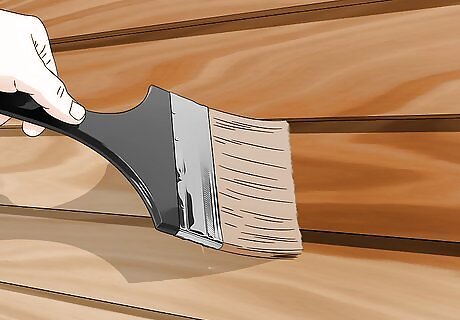
Paint or stain your wood. You may have noticed that the carpenter bees usually make their nests in untreated wood. This is because it's easier to drill through. To discourage them from making holes in the future, paint or stain the wood. In some cases, the smell of the paint or stain may bother the bees enough to keep them away.
Set out wooden structures you wouldn't mind them drilling into. To lure carpenter bees from your porch or deck, put up wooden posts or a wooden trellis away from your home or shed. Then, grow lots of flowering plants around it. This may be enough to attract the carpenter bees so they stay away from your home or shed. Carpenter bees are attracted to the nectar and pollen so flowering plants can lure them to a different part of your home. Plus, they'll pollinate the plants!
Hang traps near the area where the bees like to nest. You can buy or make a carpenter bee trap. These look like small wooden boxes that have ⁄2 in (1.3 cm) diameter holes drilled on all sides. They've got a small plastic bottle or container hanging from the bottom—the bees will drill or go through the holes only to fall into the plastic bottle. They won't be able to get out and they'll die. If you're making your own traps, you'll usually attach two plastic bottles to create a narrow, slick space that the bees can't get through.
Replace wood with composite material. If you're constantly dealing with damage from carpenter bees, it might be time to simply replace the wood. Instead of putting in new wood, use composite materials that are too strong for the carpenter bees to drill through. This is a more expensive option, but if you've been replacing wood every few years, it might be cost-effective. For example, you might install aluminum or vinyl siding to a shed that frequently gets carpenter bees.




















Comments
0 comment